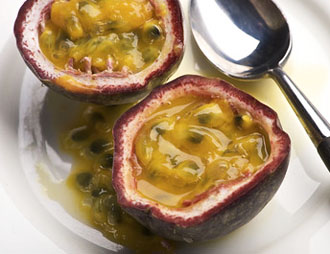Selection and storage
Passion fruits can be available year-round in supermarkets in the United States. In other parts of the world, their availability is seasonal and varies accordingly. In New Zealand, the passion fruit season begins in January, and peaks in April.
In the stores, buy fruits that are well-ripe, plump, and heavy for their size. Fruits with wrinkled surfaces are more flavorful and rich in sugar.
Avoid overtly mature fruits. Minor cuts and spots are common on the skin. Such small abrasions on the fruit surface usually do not influence the quality of the fruit.
Once at home, keep them in a fruit basket and place them in a cool dark place where they stay well for 1-2 days. Ripe fruits may be maintained in the refrigerator for up to one week. Additionally, passion fruit freezes well. Simply scoop the pulp into a bowl, add a little sugar, and freeze in the chiller tray.
Preparation and serving method
 |
| Cut section of passion-granadilla fruit. (Photo by geishaboy500) |
Wash fruit in cold water and pat dry them using a soft cloth or paper. Cut the fruit lengthwise into two halves. Then, scoop out the juicy pulp with a spoon. Discard the tough shell.
Passion fruits have a unique tart pleasant flavor and sweet taste. Purple passion fruits are smaller but more flavorful than yellow-golden passions.
Here are some serving tips:
-
Passion fruit can be enjoyed fresh, especially when the fruit is well-ripe. Just scoop out its juicy pulp using a spoon. Its tough shell, anyhow, is inedible.
-
Their juicy pulp can also be enjoyed as a refreshing intra-day drink.
-
Passions add a distinct flavor to fruit salads.
-
Passions used in the preparation of sauce, jellies, and syrups.
-
It employed in various recipes like passion fruit mousse, ice-cream, pizza, desserts, cakes, mousse…etc.
≻≻-Back to Fruits from Passion fruit. Visit here for an impressive list of all varieties of fruits with complete illustrations of
their nutrition facts and health benefits.
≻≻-Back to Home page.
Further reading and Resources:
-
USDA National Nutrient Database. (opens in new window)
-
Stanford School of Medicine Cancer information Page-Nutrition to Reduce Cancer Risk (Link opens in new window).
-
Passionfruit information – http://www.passionfruit.org.nz/.

